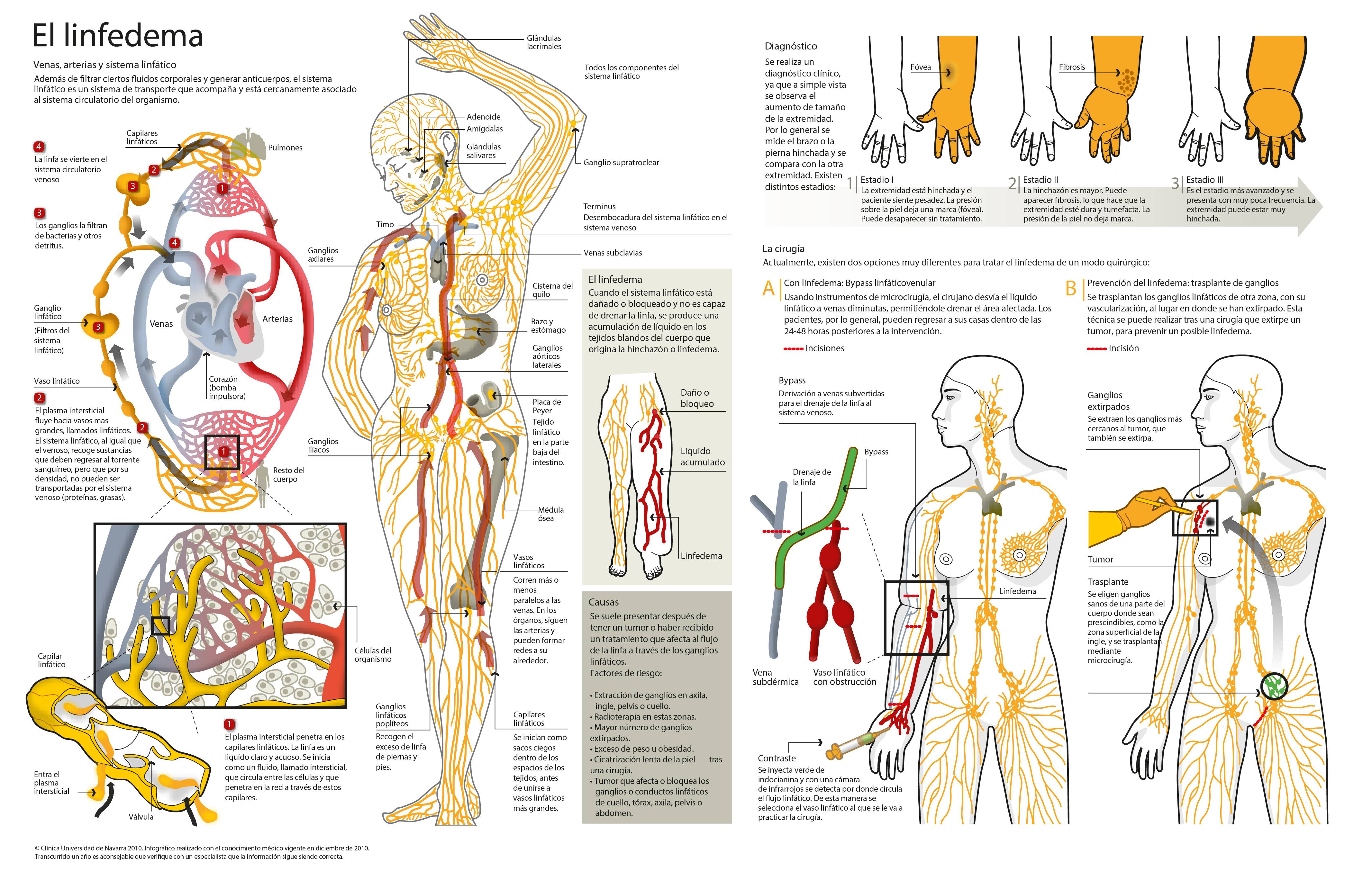Lymphedema
"Depending on the patient's condition, some of these new procedures can even be performed under local anesthesia and without the need for hospitalization".
DR. CRISTINA AUBÁ
SPECIALIST. PLASTIC, AESTHETIC AND RECONSTRUCTIVE SURGERY DEPARTMENT
Lymphedema occurs when the lymphatic system is not able to drain the lymph and causes swelling by accumulation of fluid in the soft tissues of the body.
Lymphedema can be very annoying for those who suffer from it, but with the proper treatments, 95% of patients show improvement, which is excellent in almost a third of the cases.
The Clinica Universidad de Navarra has the most advanced technology in microsurgery, powerful microscopes and highly specialized material for carrying out lymphedema treatment procedures.
We have specialists with extensive training and experience in the diagnosis and treatment of this pathology.
The surgical treatment of lymphedema can be performed to solve the symptoms caused by this pathology.
Currently there are two very different options for treating lymphedema surgically.
- Lymphatic-venular bypass and liposuction are techniques that are performed when lymphedema is already established.
- Lymph node transplantation is performed before it appears, to prevent its appearance.

What are the symptoms of lymphedema?
Lymphedema can take several forms and affect various parts of the body.
Usually it appears in the extremities, but it is also frequent in the genital areas or the face.
The patients with greater risk of suffering lymphedema are
- Cancer patients who have had nodes removed from the armpit or groin.
- Cancer patients who have received radiotherapy treatments in the armpit or groin and who develop nodal sclerosis.
Do you have any of these symptoms?
You may have lymphedema
What are the causes of lymphedema?
Lymphedema usually occurs after a tumor or treatment that affects the flow of lymph through the lymph nodes.
Risk factors:
- Removal of nodes in the armpit, pelvis, groin or neck.
- Radiation therapy in the armpit, pelvis, groin or neck.
- Increased number of nodes removed.
- Excess weight and obesity.
- Slow healing of the skin after surgery.
- Tumor affecting or blocking the nodes or lymph ducts in the neck, chest, underarm, pelvis or abdomen.
Types of lymphedema
It is classified in two types according to its origin:
Primary. Those that have no apparent cause, can be congenital or appear in adolescence or later. They are produced because the lymphatic pathways do not function normally or their number is less than necessary for their lymphatic system to be competent.
Secondary. When the lymphatic system is normal but has been altered by trauma, surgical operations, irradiations or infections.
How is lymphedema diagnosed?
A clinical diagnosis is made, since at first sight the limb's size increase is observed. Usually, the swollen arm or leg is measured and compared with the other limb.
Stage I Lymphedema
- The limb is swollen and the patient feels heavy.
- The pressure on the skin leaves a mark (pitting).
- It may disappear without treatment.
Stage II of lymphedema
- The swelling is greater.
- Fibrosis may appear, making the limb hard and swollen.
- The pressure of the skin does not leave a mark.
Stage III of lymphedema
- It is the most advanced stage and occurs infrequently.
The limb can be very swollen.
How is lymphedema treated?
The Clinic is one of the Spanish centers with more experience in this kind of techniques.
This technique consists of redirecting the circulation of the lymphatic fluid by getting it to drain into unobstructed veins of the circulatory system.
Indocyanine green is injected and with an infrared camera it is detected where the lymphatic flow circulates. In this way, the lymphatic vessel to be operated on is selected.
It is an outpatient operation and with local anesthesia in which the surgeon connects the small lymphatic vessels with the veins allowing drainage of the affected area.
Patients are usually able to go home within 24-48 hours after the operation.
This technique consists of transplanting the lymph nodes from another area, with their vascularization, to the place where they have been removed.
Nodes are chosen from another area of the body where they are dispensable, such as the superficial area of the groin, and they are transplanted by means of microsurgery.
It can be done after surgery that removes a tumor, to prevent possible lymphedema.
Where do we treat it?
IN NAVARRE AND MADRID
The Department of Plastic, Aesthetic and Reconstructive Surgery
of the Clínica Universidad de Navarra
The Department of Plastic, Reconstructive and Aesthetic Surgery has extensive experience in plastic surgery, both aesthetic and reconstructive. We are experts in microsurgical repair of blood vessels and nerves.
We have the latest technology and powerful microscopes that allow complete treatments with quality assurance and total security in any type of solution you need.
Reconstructive Surgery
- Facial paralysis
- Breast reconstruction
- Head and neck
- Vascular abnormalities
- Craniofacial
- Burns
- Auricular reconstruction
Aesthetic Surgery
- Abdominoplasty
- Blepharoplasty
- Breast Surgery
- Facial aesthetics without surgery
- Liposuction
- Otoplasty
- Rhinoplasty
Reconstructive Microsurgery
- Reconstruction with microsurgical flaps.
- Nerve microsurgery.
- Reimplants.

Why at the Clinica?
- Experience of more than 20 years in the aesthetic treatment.
- Professional experts trained in international reference centers.
- Safety: Interdisciplinary attention within a hospital center.







